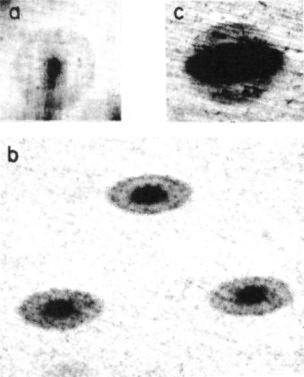| ESA | Return to https://www.halos.com/book/ctm-app-07-c.htm. | ESA |
< Prev T of C ... 12 13 14 15 Epi. Cat. App. Ref. Cred. Next >
Even without attempting to subtract out the 206Pb component of the common and "old" radiogenic Pb (15), these 238U/206Pb ratios raise some questions. For example, if the 238U/206Pb = 27,300 value is indicative of the formation time of the radiocenter, this is more recent by at least a factor of 270 than the minimum (Cretaceous) and more recent by a factor of 760 than the maximum (Triassic) geological age estimated for the introduction of U into the logs (12, 17, 18). To obtain 238U/206Pb ratios that more accurately reflect the amount of Pb from in situ U decay, a search was made for sites with even higher ratios, for such areas possibly contained negligible amounts of extraneous Pb. Two halo radiocenters were found that exhibited 238U+ signals of 4 × 104 and 6.4 × 104 cps, respectively while the 206Pb+ signals were indistinguishable from background ( 3 cps) in both cases (207Pb also absent).
Such extraordinary values admit the possibility that both the initial U infiltration and coalification could possibly have occurred within the past several thousand years. At the same time it may be argued that this view is quite improbable for there exists another explanation that could invalidate the association of the U/Pb ratios with the initial introduction of U. This explanation would admit that, although Po halos constitute evidence that U infiltration and hence U radiocenter formation occurred prior to coalification, some U may have been added or Pb may have been selectively removed, or both, by groundwater circulation after coalification. Hence variable U/Pb ratios would be expected, and the highest ratio would simply reflect the last time when U remobilization or Pb remobilization, or both, occurred. Although this hypothesis has been used to account for U disequilibrium (18, 19) in bulk specimens of U-impregnated Colorado Plateau material, there are some questions about its applicability here.
For example, if Pb was removed from the U sites, it must have been a very selective removal for both the EMXRF and IMMA results show that considerable quantities of Pb still remain in the nearby (within 50 μm of the U sites) Po halo Pb-Se inclusions. If Pb loss was minimal, then to explain the high 238U/206Pb ratios by remobilization requires that significant quantities of U were introduced into the U radiocenters quite recently. In any event, whether the hypothesis is U addition or Pb removal, the crucial point that seems quite difficult to explain under either assumption is the fact that, in general, the halos around U sites are embryonic (20). That is, since it seems clear that the U radiocenters formed during the initial introduction of U and if this were as long ago as the Triassic or Jurassic are generally thought to be. then there should be evident not only fully developed, but overexposed U halos as well (21).
Clearly, it was important to determine whether these phenomena were characteristic only of the U-rich Colorado Plateau coalified wood (2, 3). We therefore initiated studies on coalified wood fragments which are occasionally found in the Chattanooga shale (3, 11, 22). Thus far only embryonic halos have been seen, and the 238U/206Pb ratios are much too high (>103) to correlate with the geological age of the formation (Devonian). The low U content of the Chattanooga shale (1 to 50 parts per million) makes it quite difficult to see how U remobilization could account for these very high isotope ratios. Thus the evidence does not appear to support the remobilization hypothesis as a general explanation of these unusual 238U/206Pb ratios in either the Colorado Plateau or Chattanooga shale specimens.
 Fig. 3. (a) Circular 210Po halo (× 250). (b) Compressed 210Po halos (× 250). (c) Circular and compressed 210Po halo (× 250). |
If remobilization is not the explanation, then these ratios raise some crucial questions about the validity of present concepts regarding the antiquity of these geological formations and about the time required for coalification. Finally, in addition to again focusing attention on the question of the origin of Po halos in minerals (6, 10), the existence of U-derived single and dual Po halos in different formations suggests that the original source of U may have been a Precambrian ore deposit that was geographically not far removed from the present Colorado Plateau. Thus, in view of America's energy requirements, it might be profitable to search for such an ore deposit by deep drilling into selected areas around and within the Colorado Plateau.
| ROBERT V. GENTRY | |
| Chemistry Division, Oak Ridge National Laboratory, Oak Ridge, Tennessee 37830 | |
| WARNER H. CHRISTIE DAVID H. SMITH J. F. EMERY S. A. REYNOLDS RAYMOND WALKER | |
| Analytical Chemistry Division, Oak Ridge National Laboratory | |
| S. S. CRISTY | |
| Laboratory Development Division, Y-12 Plant, Oak Ridge National Laboratory | |
| P. A. GENTRY | |
| Columbia Union College, Takoma Park, Maryland 20012 |

|
Doc.: T of C ... #3 #4 #5 #6 #7 #8 #9 #10 #11 ...
< Prev T of C ... 12 13 14 15 Epi. Cat. App. Ref. Cred. Next >
© 2004
Earth Science Associates